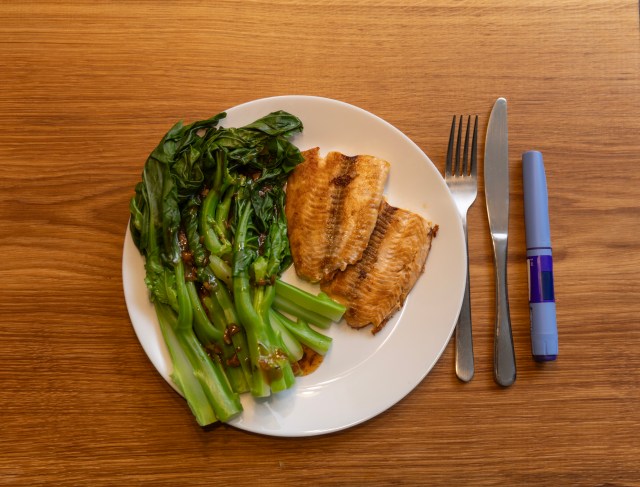When it comes to weight loss success, glucagon-like peptide-1 receptor antagonist (GLP-1 RA) injectable treatments are a potent tool. These medications, usually containing semaglutide or tirzepatide, target the incretin hormone pathways, which play a role in regulating appetite and satiety. As a result, patients using GLP-1 RAs typically experience reduced hunger and caloric intake, often leading to rapid and substantial weight loss, particularly in the first six months.(1)
While GLP-RAs offer benefits, they may also come with emerging related challenges. Understanding the nuances of weight loss versus fat loss, the impact of reduced nutrient intake, and the importance of a lifelong, sustainable dietary pattern is essential for setting patients up for long-term success.
Explaining Weight Loss vs. Fat Loss
Seeing the number on the scale go down can feel gratifying when weight loss is the goal. Being at a healthy weight helps reduce comorbidities often associated with overweight/obesity such as heart disease, hypertension and diabetes (2). Fat accumulation in the midsection is particularly associated with increased risk of heart disease, and reducing visceral fat can help improve cardiovascular health (3).
However, weight reduction reflected on the scale isn’t only body fat. Some of that loss is muscle and bone.(1,4) Reductions in bone mass can lead to osteoporosis, and losing muscle can make people weaker and frailer. On the other hand, the proportion of muscle mass an individual retains is associated with longevity outcomes.(5)
To help counteract muscle and bone loss, health professionals can recommend strategies to help maintain bone and muscle mass, such as following a strength training regimen and consuming adequate protein. (1) Keep in mind, muscle is a highly metabolic organ, which means it requires more calories just to be maintained.
Nutritional Considerations: Quality Over Quantity
One of the primary effects of GLP-1 RAs is reduced hunger, often leading to a significant drop in food intake. While this supports caloric deficit, it can also result in insufficient intake of essential nutrients – particularly protein, calcium, magnesium, and vitamin D, (1) all of which are key nutrients for maintaining muscle and bone integrity and supporting overall health.
With less total food consumed, nutrient density becomes a top priority. Healthcare professionals should emphasize whole, nutrient-rich foods and work with patients to ensure their limited intake is still meeting core nutritional needs.

Preparing for the Long Haul
GLP-1 RAs are remarkably effective, but long-term adherence is low, with data suggesting only about one-half to one-third continuing using GLP-1 RAs at 1 year, and about 15% at the 2-year mark (1). Since most people embarking on a weight-loss journey begin with sub-optimal eating habits that enabled the initial overweight/obesity, health professionals can discuss strategies that not only address nutrient deficiency, but also how to eat healthfully should the patient choose to wean off of the medication.
Low-Carb Diets for Weight Loss Success
People who have experienced significant long-term weight loss success tend to consume nutrient-rich foods, prioritizing protein and fiber; eat at regular intervals; and avoid skipping meals (1). High-protein/low-carbohydrate diets also have been shown to prioritize fat loss and spare the loss of lean body mass such as muscle and bone (6).
Prioritizing protein is effective for weight loss and maintenance because protein is a powerhouse nutrient that’s involved in muscle, bone and skin health. Plus, it is highly satiating, which helps prevent against overeating. Recommended daily intake for protein is 1.2 to 2.0 grams/kg body weight based on the patient’s target appropriate weight. Foods such as fish, eggs, Greek yogurt, nuts and seeds are all nutrient-rich, protein-packed foods that work well in low-carb diets.
A Multidisciplinary, Patient-Centered Approach
Supporting patients on GLP-1 RA therapy requires an integrated, individualized care plan. Ideally, this includes:
- The prescribing clinician, who monitors medication response and side effects.
- A registered dietitian/nutritionist, who tailors dietary strategies to reduce lean mass loss and ensure nutrient adequacy.
- A fitness professional, who guides physical activity with a focus on strength training and cardiovascular fitness.
- A mental health provider, who can address the emotional and behavioral aspects of eating and body image.
Importantly, care plans should be culturally sensitive and adaptable to each patient’s preferences, lifestyle, and support system. What works for one patient may not be feasible, or sustainable, for another.
Meal planning tools like the Atkins 100® Vegetarian, Mediterranean and DASH Diet handouts can be a launching point for individualization with your patient.